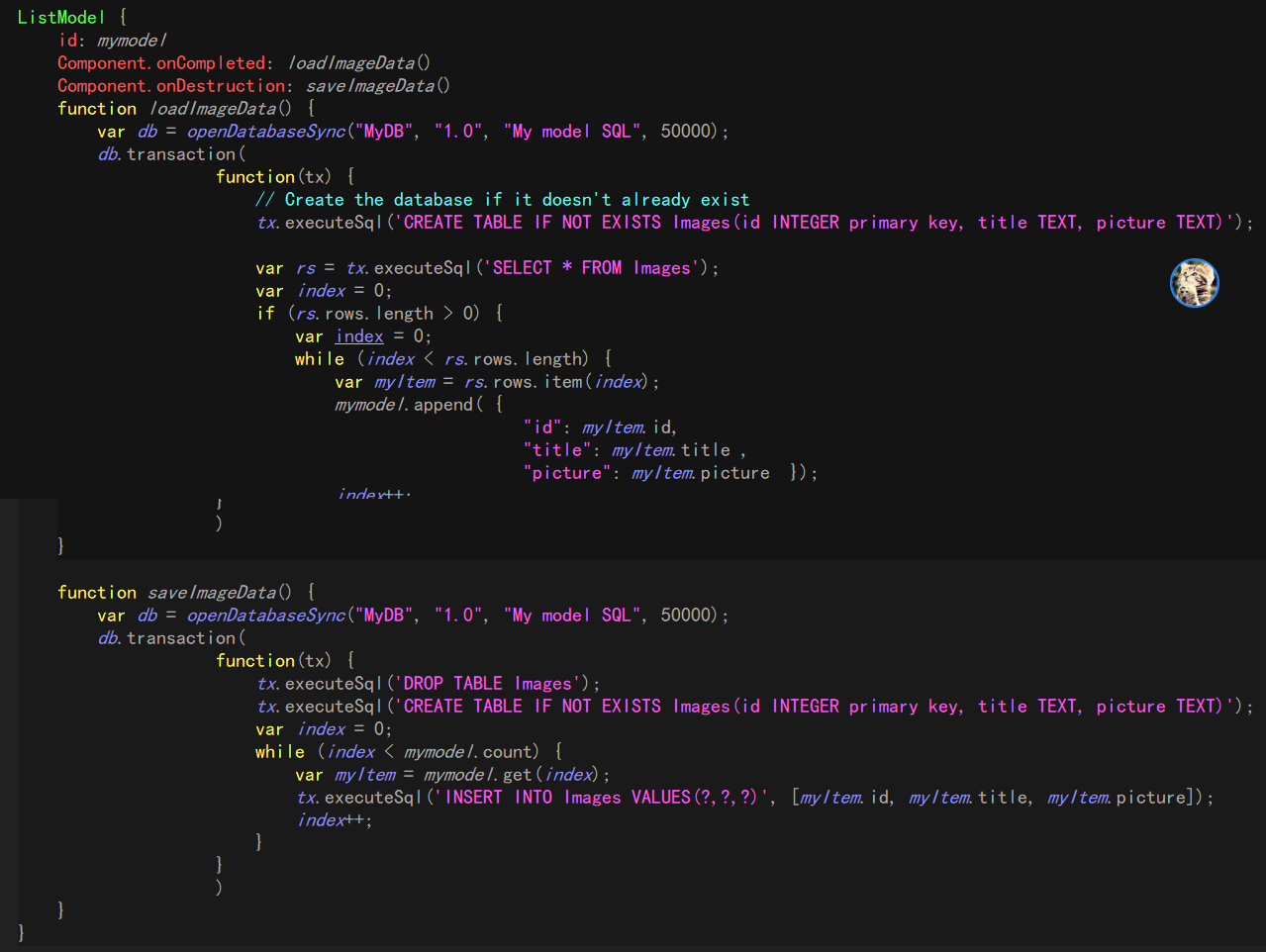Models 是用来提供数据的,它既可以以 QML 的形式出现也可以是 C++的类。QML中的Model有ListModel、XmlListModel、
VisualItemModel;C++ 中的 Model 有 QAbstractItemModel、QStringList、 QList<QObject*>等。另外我们可以把数
据存到数据库里,程序启动的时候从数据库中读取数据,退出的时候把Model中的数据存放回数据库中。主要代码如下所示:

ListModel {
id: mymodel
Component.onCompleted: loadImageData()
Component.onDestruction: saveImageData()
function loadImageData() {
var db = openDatabaseSync("MyDB", "1.0", "My model SQL", 50000);
db.transaction(
function(tx) {
// Create the database if it doesn't already exist
tx.executeSql('CREATE TABLE IF NOT EXISTS Images(id INTEGER primary key, title TEXT, picture TEXT)');
var rs = tx.executeSql('SELECT * FROM Images');
var index = 0;
if (rs.rows.length > 0) {
var index = 0;
while (index < rs.rows.length) {
var myItem = rs.rows.item(index);
mymodel.append( {
"id": myItem.id,
"title": myItem.title ,
"picture": myItem.picture });
index++;
}
} else {
mymodel.append( {
"id": 1,
"title": 'apple' ,
"picture": 'content/pics/apple.png' });
mymodel.append( {
"id": 2,
"title": 'Qt Quick!' ,
"picture": 'content/pics/Qt.png' });
}
}
)
}
function saveImageData() {
var db = openDatabaseSync("MyDB", "1.0", "My model SQL", 50000);
db.transaction(
function(tx) {
tx.executeSql('DROP TABLE Images');
tx.executeSql('CREATE TABLE IF NOT EXISTS Images(id INTEGER primary key, title TEXT, picture TEXT)');
var index = 0;
while (index < mymodel.count) {
var myItem = mymodel.get(index);
tx.executeSql('INSERT INTO Images VALUES(?,?,?)', [myItem.id, myItem.title, myItem.picture]);
index++;
}
}
)
}
}
动态添加数据是非常简单的,比如我们在 onClicked 事件中可以这样做:
onClicked: mymodel.append( { "title": 'Qt', "picture": 'content/pics/Qt.png' })
删除数据:
onClicked: mymodel.remove(listView.currentIndex)
下面是官方文档:
Offline Storage API
Database API
The openDatabaseSync() and related functions provide the ability to access local offline storage in an SQL database.
These databases are user-specific and QML-specific, but accessible to all QML applications. They are stored in the Databases subdirectory ofQDeclarativeEngine::offlineStoragePath(), currently as SQLite databases.
The API can be used from JavaScript functions in your QML:
import Qt 4.7
Text {
text: "?"
function findGreetings() {
var db = openDatabaseSync("QDeclarativeExampleDB", "1.0", "The Example QML SQL!", 1000000);
db.transaction(
function(tx) {
// Create the database if it doesn't already exist
tx.executeSql('CREATE TABLE IF NOT EXISTS Greeting(salutation TEXT, salutee TEXT)');
// Add (another) greeting row
tx.executeSql('INSERT INTO Greeting VALUES(?, ?)', [ 'hello', 'world' ]);
// Show all added greetings
var rs = tx.executeSql('SELECT * FROM Greeting');
var r = ""
for(var i = 0; i < rs.rows.length; i++) {
r += rs.rows.item(i).salutation + ", " + rs.rows.item(i).salutee + "\n"
}
text = r
}
)
}
Component.onCompleted: findGreetings()
}
The API conforms to the Synchronous API of the HTML5 Web Database API, W3C Working Draft 29 October 2009.
The SQL Local Storage example demonstrates the basics of using the Offline Storage API.
db = openDatabaseSync(identifier, version, description, estimated_size, callback(db))
Returns the database identified by identifier. If the database does not already exist, it is created with the properties description and estimated_size and the function callback is called with the database as a parameter.
May throw exception with code property SQLException.DATABASE_ERR, or SQLException.VERSION_ERR.
When a database is first created, an INI file is also created specifying its characteristics:
| Key | Value |
|---|---|
Name |
The name of the database passed to openDatabase() |
Version |
The version of the database passed to openDatabase() |
Description |
The description of the database passed to openDatabase() |
EstimatedSize |
The estimated size of the database passed to openDatabase() |
Driver |
Currently "QSQLITE" |
This data can be used by application tools.
db.changeVersion(from, to, callback(tx))
This method allows you to perform a Scheme Upgrade.
If the current version of db is not from, then an exception is thrown.
Otherwise, a database transaction is created and passed to callback. In this function, you can call executeSql on tx to upgrade the database.
May throw exception with code property SQLException.DATABASE_ERR or SQLException.UNKNOWN_ERR.
db.transaction(callback(tx))
This method creates a read/write transaction and passed to callback. In this function, you can call executeSql on tx to read and modify the database.
If the callback throws exceptions, the transaction is rolled back.
db.readTransaction(callback(tx))
This method creates a read-only transaction and passed to callback. In this function, you can call executeSql on tx to read the database (with SELECT statements).
results = tx.executeSql(statement, values)
This method executes a SQL statement, binding the list of values to SQL positional parameters ("?").
It returns a results object, with the following properties:
| Type | Property | Value | Applicability |
|---|---|---|---|
int |
rows.length |
The number of rows in the result |
SELECT |
var |
rows.item(i) |
Function that returns row i of the result |
SELECT |
int |
rowsAffected |
The number of rows affected by a modification |
UPDATE, DELETE |
string |
insertId |
The id of the row inserted |
INSERT |
May throw exception with code property SQLException.DATABASE_ERR, SQLException.SYNTAX_ERR, or SQLException.UNKNOWN_ERR.